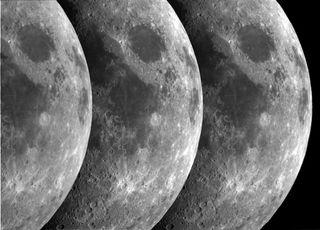Moonmoons (Moons That Orbit Other Moons) Could Exist, Scientists Say

True to form, the internet has endeavored to name an unnamed thing, and the results are hilarious. From the people who brought you Boaty McBoatface— the Arctic research drone that has already returned some very interesting discoveriesfrom the world's coldest abysses — here come moonmoons: moons that orbit other moons.
Moonmoons — also known online as submoons, moonitos, grandmoons, moonettes and moooons — may not exist in our solar system or any other. However, according to a pair of astronomers writing in the preprint journal arXiv.org earlier this week, the concept of a moon hosting its own mini-moon is, at least, plausible. [Top 10 Amazing Moon Facts]
"In all known planetary systems, natural satellites occur in a restricted dynamical phase space: Planets orbit stars, and moons orbit planets," the researchers wrote in their new paper (published online Oct. 9). "It is natural to ask, 'Can submoons orbit moons?'"
Study author Juna Kollmeier's son asked her that same question in 2014, Gizmodo reported. Kollmeier, an astronomer at the Observatories of the Carnegie Institution of Washington, D.C., didn't have a good answer then. While no known moonmoons reside in our solar system, the phenomenon does seem possible. After all, Earth's moon is so massive that some scientists want to call it a planet in its own right; why shouldn't this planet-size moon have its own moon?
In their new paper, Kollmeier and her colleague Sean Raymond, an astronomer at the University of Bordeaux in France, looked for a mathematical answer to the moonmoon puzzle. Using equations designed to show the tidal effects of planets on their moons, the team determined that moonmoons (or "submoons," as these researchers called the objects) could hypothetically exist if the host moon is sufficiently massive, the submoon is sufficiently small, and there is a wide orbital gulf between those moons and their host planet.
"We find that 10 km-scale [6 miles] submoons can only survive around large (1,000-km-scale) [600 miles] moons on wide-separation orbits," the researchers wrote. If these persnickety parameters are not met, the host planet's tidal forces would either be great enough to smash the moon and submoon together or weak enough that the submoon would get jettisoned into space.
Based on this criteria, a handful of moons in our solar system could hypothetically host mini-moons of their own, "including Saturn's moons Titan and Iapetus, Jupiter's moon Callisto, and Earth's moon."
That's right: Our very own moon could have its very own moonmoon! Why it doesn't is a question that Kollmeier and Raymond said they hope to answer with further study.
"The existence, or lack thereof, of submoons may yield important constraints on satellite formation and evolution in planetary systems," the authors wrote.
Once that's settled, the next natural question will be whether a moonmoon can host its own moonmoonmoon — and, if so, what the proper name would be for it. A great-grandmoon? Moony McMoonface? Truly, the sky's the limit.
Originally published on Live Science.
Sign up for the Live Science daily newsletter now
Get the world’s most fascinating discoveries delivered straight to your inbox.

Brandon is the space/physics editor at Live Science. His writing has appeared in The Washington Post, Reader's Digest, CBS.com, the Richard Dawkins Foundation website and other outlets. He holds a bachelor's degree in creative writing from the University of Arizona, with minors in journalism and media arts. He enjoys writing most about space, geoscience and the mysteries of the universe.
Most Popular

By Harry Baker

By Deepa Jain

By Tom Metcalfe

By Deepa Jain